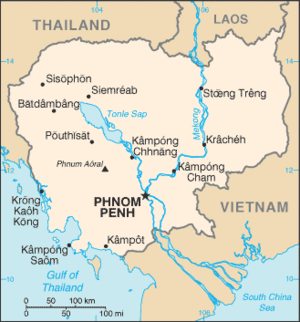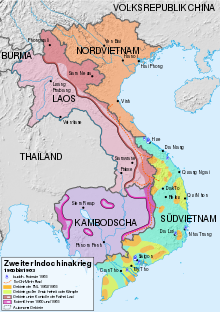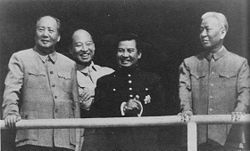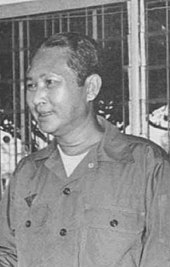Cambodian Civil War
Cambodian Civil War
Part of: Second Indochina War

Cambodia
The Cambodian Civil War was a war between the Communist Party of Kampuchea (also known as the Khmer Rouge) and the United National Front of Cambodia on one side and the Khmer Republic government forces on the other. Due to the strategic importance of Cambodia for both parties in the parallel Vietnam War, the troops of the Democratic Republic of Vietnam (North Vietnam) and the National Front for the Liberation of Vietnam (Vietcong) on one side and those of the United States of America and the Republic of Vietnam (South Vietnam) on the other side joined in the fighting.
The fighting was both prolonged and exacerbated by international interference. North Vietnamese and Viet Cong forces were trying to maintain their supply routes and bases located in eastern Cambodia. These were strategically important to the fighting in southern Vietnam. The Americans tried to prevent the emergence of a new communist regime in the west of their ally South Vietnam in order to be able to guarantee its sole survival in the medium term. Therefore, the Americans intervened in the fighting with commando operations and area bombardments and supplied the government of Lon Nol with both weapons and financial resources.
After five years of war, during which a large part of the country's economy had been destroyed and famine had weakened the population, the Khmer Rouge were able to defeat the government forces. The war, marked by many wartime atrocities, officially ended with the proclamation of Democratic Kampuchea by the Khmer Rouge on April 17, 1975. Some historians today believe that U.S. interference in the civil war ultimately aided the Communists' victory and the growth of their troop strength from 14,000 in 1970 to over 70,000 in 1975. This viewpoint, however, is challenged by many historians. John Del Vecchio, for example, argues that even before the American intervention, some 100,000 Cambodian and Vietnamese troops already occupied two-thirds of the country. Dmitry Mosyakov reports that Soviet archival sources revealed that the North Vietnamese invasion of 1970 took place at the express request of the Khmer Rouge under its chief negotiator, Nuon Chea, and not ostensibly to protect their own bases.
The end of the war was immediately followed by the Khmer Rouge genocide, which claimed the lives of approximately one to two million people in Cambodia.
Prehistory (1965-1970)
Background
During the mid-1960s, the Cambodian head of state, Prince Norodom Sihanouk, was able to avoid his country being dragged into the chaos that had already gripped the neighboring countries of Laos and Vietnam by pursuing a neutralist policy. Both the People's Republic of China and the Democratic Republic of Vietnam attested to the prince's "progressive" policy. Moreover, both countries acknowledged that Sihanouk had included the leftist opposition party Pracheachon in the government. On May 3, 1965, he finally severed diplomatic relations with the United States because its troops fighting in Vietnam had violated the Cambodian border. This meant an end to large-scale American aid shipments to Cambodia. Instead, the country turned further to the Soviet Union and China, which promised substantial economic and military aid.
In the late 1960s, Sihanouk's balancing domestic and foreign policies began to turn more and more against him. In 1966, for example, he had to agree to the stationing of large contingents of the Vietnamese People's Army and the Viet Cong on Cambodian territory in an agreement with the Chinese, who set up supply bases there. He also had to open the port of Sihanoukville to ships from all Communist countries, so that large quantities of arms destined for Vietnam were soon delivered through it. These concessions further weakened the neutrality to which Cambodia had committed itself at the Indochina Conference.
This change of course came about because Sihanouk believed that China, not the United States, would be the hegemonic power over Indochina in the future, and that our interests would be best served by cooperating with the camp that would dominate Asia in the future - and that cooperation must begin before its power - in order to put us in the best possible position.
Later that year, however, he allowed the openly pro-American Defense Minister, General Lon Nol, to launch a crackdown on Cambodian leftist activities. The latter subsequently crushed the Pracheachon and arrested many of its members on charges of plotting with North Vietnam and planning an overthrow. At the same time, Sihanouk was increasingly losing the support of conservative factions as he failed to come to grips with the ever-worsening economic situation, triggered by a slump in rice exports, an ever-increasing proportion of which were sent to the Vietnamese People's Army and the Viet Cong. Since 1966, Cambodia sold about 100,000 tons of rice to the Vietnam People's Army, which offered the world price for it and paid in U.S. dollars. In reality, however, the North Vietnamese government paid only a small, fixed price, which deprived Cambodia of enormous revenues. In addition, the remaining rice export plummeted from 583,700 tons in 1965 to 199,049 tons the following year, as farmers on the black market got prices much higher than those set by the government.
On 11 September, the first free elections were held in Cambodia. Through massive electoral fraud and voter influence, the conservatives managed to win a total of 75 percent of the seats in the National Assembly. As a result, Lon Nol was elected prime minister and Sirik Matak, an ultraconservative member of the royal family and an avowed opponent of Sihanouk, was elected his deputy. This dominance of the conservatives in the government ensured that various communist groups in the country began to infiltrate government organizations and incite the people.
The Samlaut Rebellion
This polarization of Cambodian politics posed a major problem for Sihanouk himself. In order to maintain political balance against the growing power of the conservatives, he appointed some leaders of the organizations he had only a short time before ordered to be fought to form a "counter-government" that would critically evaluate the actions of Lon Nol's government. Lon Nol's first objective was to consolidate the devastated economy by ordering the black market for the sale of rice to the communist forces in the country to cease. To this end, soldiers were sent to the main growing areas to supervise the harvest. Peasants were allowed to sell their rice only to these supervisors and received only the low central price set by the government. This led to widespread unrest, centered in the rice-rich province of Battambang, where the Communists were very influential in some cases. This was because there were many large landowners in the province and the income disparity was very large.
On March 11, 1967, while Sihanouk was on a state visit to France, an open rebellion broke out in the Samlaut district of Battambang when angry villagers attacked a group of tax collectors. Presumably through the support and incitement of local communist cadres, the uprising quickly spread throughout the region. Lon Nol responded to this uprising by imposing martial law. During the suppression of the uprising, hundreds of civilians were killed and several villages were completely destroyed. Due to this uprising, Sihanouk decided to change his previous balance policy upon his return in late March and ordered the arrest of Khieu Samphan, Hou Yuon and Hu Nim, the leaders of the "counter-government". However, all three managed to flee to the northeast of the country, where the central government effectively exercised no governing power.
At the same time, he ordered the arrest of Chinese smugglers who organized the illegal rice trade and caused enormous losses to the state. He thus fulfilled a long-standing demand of the conservatives. As a next step, Sihanouk dismissed Lon Nol from office and appointed a new government of more left-leaning politicians who were supposed to counterbalance the overwhelming power of the conservatives in the National Assembly. The acute government crisis was thus overcome, but the Samlaut uprising and its brutal repression resulted in thousands of new recruits joining the Communist Party of Cambodia, called simply Khmer Rouge (Khmer Rouge) by Sihanouk, and Lon Nol's name became synonymous with brutal repression in large parts of the population.
Reorganization of the Communists
While the 1967 uprising was unplanned and surprising even to the Khmer Rouge, a centrally organized, major popular uprising was to take place the following year. The crushing of the Pracheachon and urban communist cells by the government apparatus had left a vacuum in the Communist leadership that was filled by Pol Pot, Ieng Sary, and Son Sen, the leaders of the Maoist underground movement in the countryside. These gathered new fighters around them and retreated to the mountainous region in the northeast of the country, the land of the Khmer Loeu. These were a tribe of people considered backward and generally hostile to both the central government and most of the inhabitants of the lowlands. The Khmer Rouge, who had still not succeeded in obtaining active aid from North Vietnam, used this time, when they were relatively protected from government persecution, to rebuild their structures and train their soldiers. Even after renewed requests, the North Vietnamese ignored their mainly Chinese-backed allies and were relatively indifferent to them, behavior that also later permanently strained the relationship between the "brotherly comrades."
On 17 January 1968, the Khmer Rouge launched their first planned offensive against the government. The operation, which involved no more than 4,000-5,000 fighters, was more about capturing more weapons and propaganda than occupying territory, and the Khmer Rouge soon retreated back to their initial position. At the same time, they established the Revolutionary Army of Kampuchea as the armed arm of the party. In parallel, Sihanouk had already been trying for several months to establish new contacts with the Communists, so that they could possibly participate in the government again in the future. He did this because his earlier agreements with the Chinese turned out to be worthless. They did not limit North Vietnamese influence in the border area; Sihanouk even blamed them for the Communist uprising in the country.
At the behest of Lon Nol, who had returned to the cabinet as defense minister in November 1968, and other conservative politicians, Sihanouk resumed normal relations with the U.S. on May 11, 1969, and announced the appointment of a new Government of National Liberation with Lon Nol as prime minister. He did this "to play a new card as the Asian Communists have been attacking us since before the Vietnam War ended." Sihanouk thus blamed the Vietnamese People's Army and the Viet Cong, which partially occupied the east of the country, rather than the Khmer Rouge, for Cambodia's problems, suggesting that withdrawal of these troops would solve much of the problem. The Americans seized on this thesis, proclaiming that such a withdrawal would solve not only Cambodia's problems but a host of others in Southeast Asia.
Operation MENU
See also: Operation MENU
Although the U.S. had been aware since 1966 that the Vietnamese People's Army and Viet Cong maintained retreat camps and supply routes in Cambodia, President Lyndon B. Johnson decided against bombing these areas to avoid international protests. He also feared Prince Sihanouk might turn fully to the Communists after such an action. Johnson did, however, allow reconnaissance teams from MACV-SOG, the Military Assistance Command, Vietnam Studies and Observations Group, to be sent into Cambodia to secretly gather intelligence on the Vietnamese military infrastructure. However, the election of Richard Nixon as U.S. president and his plan for a phased withdrawal from Vietnam and the Vietnamization of the war changed this basic attitude. Plans were now made to massively bomb and destroy the enemy's supply bases abroad as well, in order to facilitate the deployment of ground troops. On March 18, 1969, on Nixon's secret orders, 59 Boeing B-52 bombers bombed Base Area 353 in Cambodia, just across the Vietnamese border from Tay Ninh province. This was only the first of a series of air strikes on Cambodian territory that continued until May 1970. During Operation MENU, the Air Force flew a total of 3,875 airstrikes, dropping over 108,000 tons of bombs on the eastern border areas. Throughout the operation, Sihanouk did not comment on the bombing in the hope that it might actually drive the Vietnam People's Army and Viet Cong out of Cambodia. North Vietnam also issued no statement on the bombings, not wanting to alert world public opinion to the presence of North Vietnamese troops in neutral Cambodia. Therefore, the bombings of Operation MENU remained secret not only from the public but also from the US Congress until 1973.

Situation in Indochina at the beginning of the 1960s

Mao Zedong (left), Prince Sihanouk (center) and Liu Shaoqi (right) at a meeting in Beijing.
The fall of Sihanouk
Lon Nol's takeover
While Prince Sihanouk was again on a foreign trip to France, anti-Vietnamese riots broke out in Phnom Penh in March 1970, resulting in the looting and destruction of North Vietnamese and Viet Cong missions in the city. Lon Nol, who exercised sole governmental authority in Sihanouk's absence, did nothing to contain the unrest. On March 12, moreover, he closed the port of Sihanoukville to all North Vietnamese shipments and issued an ultimatum to all Vietnamese troops to leave the country within 72 hours. Otherwise, military action by the Cambodian army was to be expected.
When Sihanouk heard of the unrest, he rushed to Moscow and Beijing to ask the North Vietnamese protectors to intervene and force their withdrawal, but to no avail. On March 18, the day after the ultimatum expired without results, Lon Nol demanded that the National Assembly hold an election to vote on Sihanouk's future as head of state. With a result of 92 to 0, Sihanouk was removed from office and Cheng Heng was appointed as the new president of the National Assembly, while Lon Nol was given the right of emergency legislation as prime minister. Sirik Matak again held the post of deputy prime minister. The new government issued a government statement stating that the transfer of power was done through legal means and was therefore lawful, and as a result received the recognition of most foreign governments within a short period of time. Since the change of power, there have been allegations that the US played a role in Sihanouk's overthrow, but these have not been proven to date.
Particularly among the middle class and intellectuals, who were weary of Sihanouk's perceived fickle policies, the prince's removal from power was viewed with favor. This position was echoed by the military, which saw the resumption of U.S. financial and military aid as a means of securing its existence. Within days of his overthrow, Sihanouk, who had found asylum in Beijing, began broadcasting radio transmissions to Cambodia calling on the people to rebel against the usurpation. As a result, there were sporadic demonstrations and riots in favor of Sihanouk, but these were largely confined to Vietnamese-controlled territory and posed no threat to the new government. The only more significant actions by government opponents were the assassination of Lon Nol's brother Lon Nil in Kampong Cham during a demonstration on March 28, after which his body was mutilated by the crowd, and the march of an estimated 40,000 demonstrators on the capital, which was intended to overthrow the government. However, this was crushed by military units; there were many deaths.
Massacre of the Vietnamese
Many Cambodians blamed the Vietnamese, both North Vietnamese and Viet Cong soldiers, as well as the Vietnamese minority population for the poor situation in the country. Therefore, Lon Nol's call to recruit 10,000 volunteers to reinforce the ill-equipped 30,000-strong army and drive the Vietnamese troops out of the country was enthusiastically received and over 70,000 volunteers came forward. While the volunteers were still being recruited, rumors surfaced that the Vietnamese People's Army was planning to take Phnom Penh in an offensive and install a communist regime. This led to violent attacks on the approximately 400,000 ethnic Vietnamese in Cambodia.
Lon Nol hoped to use the ethnic Vietnamese as hostages against North Vietnam to prevent an attack and ordered the military to imprison a large number of them in camps. As the captures began, the killing of many Vietnamese occurred simultaneously. In many places, the panic against the Vietnamese Fifth Column continued to increase, so that many Cambodians murdered their Vietnamese neighbors. The military also participated in these massacres. On April 15, these massacres first became known to the world public when the bodies of over 800 murdered Vietnamese floated in the Mekong River across the border into South Vietnam.
Both North and South Vietnam and the Viet Cong strongly condemned these killings. In his subsequent apology to the South Vietnamese government, Lon Nol said.
"that it was difficult to distinguish between ordinary Vietnamese and members of the Viet Cong. Therefore, it was normal that the reaction of the Cambodian troops, who felt betrayed, was difficult to control."
- Lon Nol:
RADIO and GRUNK
From Beijing, Sihanouk announced the dissolution of the government in Phnom Penh and the planned formation of the United National Front of Kampuchea (Front uni national du Kampuchéa), or FUNK. Sihanouk later said that until Lon Nol's coup he had chosen neither the American nor the communist side, seeing a danger in both American imperialism and Asian communism. Lon Nol's actions, however, had forced him to make a decision.
Subsequently, the prince openly allied himself and his United National Front with the Khmer Rouge, the North Vietnamese, the Viet Cong, and the Laotian Pathet Lao and backed their aims. On May 5, he proclaimed the United National Front and the Royal Government of the National Union of Kampuchea (Gouvernement Royal d'Union Nationale du Kampuchéa) or GRUNK. He appointed himself head of state and Penn Nouth, one of his most loyal followers, as prime minister. Khieu Samphan was given the post of deputy prime minister and minister of defense, as well as commander-in-chief of the GRUNK armed forces. However, these were under Pol Pot rather than Khieu. Hu Nim became Minister of Information and Hou Yuon was given the Ministry of Home Affairs, Communal Reforms and Cooperation. Since Khieu Samphan and other leaders of the armed resistance were still inside the country, the GRUNK did not consider itself a government in exile. However, Sihanouk and many of his followers stayed in China throughout the war, except for a visit by the prince to the liberated areas and Angkor Wat in March 1973.
He saw the alliance with the Communists mainly as a short-term marriage of convenience to get revenge on those who had betrayed him in his eyes. However, the Khmer Rouge were able to benefit much more from this alliance, as it provided them with some sort of legitimacy among large segments of the population. Many citizens loyal to the crown therefore supported FUNK's cause. Sihanouk's statement that the communist troops would behave far better towards the civilian population than the Americans, who had bombed the country indiscriminately, drove more people into the arms of the FUNK. But their cause was most strongly supported by Lon Nol himself, when he abolished the federal monarchy and proclaimed the centralist Khmer Republic.

Lon Nol
Search within the encyclopedia